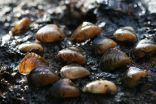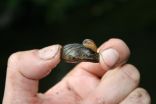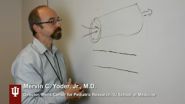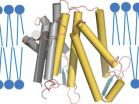(Press-News.org) Five of the most high-risk freshwater invaders from the Ponto-Caspian region around Turkey and Ukraine are now in Britain - including the quagga mussel, confirmed just two weeks ago on 1 October in the Wraysbury River near Heathrow airport.
Researchers say that, with at least ten more of these high-risk species established just across the channel in Dutch ports, Britain could be on the brink of what they describe as an 'invasional meltdown': as positive interactions between invading species cause booming populations that colonise ecosystems - with devastating consequences for native species.
The authors of a new study on 23 of high-risk invasive species, published today in the Journal of Applied Ecology, describe Britain's need to confront the Ponto-Caspian problem - named for the invaders' homelands of the Black, Azov and Caspian seas - as a "vital element for national biosecurity".
They say monitoring efforts should be focused on areas at most risk of multiple invasions: the lower reaches of the Rivers Great Ouse, Thames and Severn and the Broadlands, where shipping ballast water and ornamental plant trading is most likely to inadvertently deposit the cross-channel invaders.
All of these areas are projected to see an influx of up to twenty Ponto-Caspian invading species in the near future.
"Pretty much everything in our rivers and lakes is directly or indirectly vulnerable," said Dr David Aldridge, co-author from the University of Cambridge's Department of Zoology, who confirmed the quagga find.
"The invader we are most concerned about is the quagga mussel, which alarmingly was first discovered in the UK just two weeks ago. This pest will smother and kill our native mussels, block water pipes and foul boat hulls. We are also really worried about Ponto-Caspian shrimps, which will eat our native shrimps,"
The most aggressive invasive shrimp have ominous monikers: the demon shrimp, bloody red shrimp and the notorious killer shrimp - dubbed the 'pink peril'.
These organisms have already been recorded in Britain, and experts warn they will act as a gateway for further species due to favourable inter-species interactions that facilitate invasion, such as food provision and 'commensalism' - in which one species obtains benefits from another's place in an ecosystem.
The researchers point to the example of the zebra mussel, a Ponto-Caspian outrider and relation of the quagga first seen in the UK in 1824 and now widespread. Zebra and quagga mussels smother Britain's native mussels, preventing them from feeding and moving. The invading mussels also provide an ideal home for Ponto-Caspian amphipods such as killer and demon shrimps, which have striped patterns to blend in with the mussels' shells.
These amphipods, in turn, provide food for larger invaders such as goby fish. Ponto-Caspian gobies have now made their way down the Rhine, one of the main "corridors" to Britain, with populations exploding in the waterways of western France over the last few years. The invading gobies eat native invertebrate and displace native fish such as the already threatened Bullhead.
Once the Ponto-Caspian species reach coastal areas of The Netherlands, they are transported across the channel in ballast water taken on by cargo ships, or hidden in exported ornamental plants and aquatic equipment such as fishing gear.
"If we look at The Netherlands nowadays it is sometimes hard to find a non-Ponto-Caspian species in their waterways," said Aldridge.
"In some parts of Britain the freshwater community already looks more like the Caspian Sea. The Norfolk Broads, for example, typically viewed as a wildlife haven, is actually dominated by Ponto-Caspian zebra mussels and killer shrimps in many places."
"Invasive species – such as the quagga mussel – cost the UK economy in excess of £1.8 billion every year," said Sarah Chare, deputy director of fisheries and biodiversity at the UK Environment Agency.
"The quagga mussel is a highly invasive non-native species, affecting water quality and clogging up pipes. If you spot one then please report it to us through the online recording form."
Through an in-depth analysis of all reported field and experimental interactions between the 23 most high-risk invasive Ponto-Caspian species, the researchers were able to identify 157 different effects - the majority of which enabled positive reinforcement between species (71) or made no difference (64).
Dates and locations of the first British reports of 48 other freshwater invaders from around the world show that 33% emerged in the Thames river basin, making it the UK hot spot for invaders, followed by Anglian water networks (19%) and the Humber (15%).
The time between a Ponto-Caspian species being reported in The Netherlands and Britain has shrunk considerably - from an average of 30 years at the beginning of the 20th century to just 5 in the last decade.
"Due to globalisation and increased travel and freight transport, the rate of colonisation of invasive species into Britain from The Netherlands keeps accelerating - posing a serious threat to the conservation of British aquatic ecosystems," said co-author Dr Belinda Gallardo, now based at the Doñana Biological Station in Spain.
"Cross-country sharing of information on the status and impacts of invasive species is fundamental to early detection, so that risks can be rapidly assessed. A continuing process for evaluating invasive species and detecting new introductions needs to be established, as this problem is increasing dramatically."
INFORMATION: END
Britain on brink of freshwater species 'invasion' from south east Europe
2014-10-13
ELSE PRESS RELEASES FROM THIS DATE:
Hillary Rodham Clinton to unveil early literacy toolkit for pediatricians and parents
2014-10-13
SAN DIEGO – Former Secretary of State Hillary Rodham Clinton will discuss the role that pediatricians and parents can play in promoting young children's early learning during her remarks on Sunday Oct. 12 at the American Academy of Pediatrics (AAP) National Conference & Exhibition in San Diego. Secretary Clinton will announce the launch of the Academy's updated early literacy toolkit for pediatricians and parents, Books Build Connections, which will be shared with its 62,000 pediatrician members immediately following Secretary Clinton's remarks.
In June 2014, the ...
A novel platform for future spintronic technologies
2014-10-12
Spintronics is an emerging field of technology where devices work by manipulating the spin of electrons rather than their charge. The field can bring significant advantages to computer technology, combining higher speeds with lower energy consumption. Spintronic circuits need ways to control electron spin without interference from electron charge. Scientists at EPFL, working with Université Paris-Sud and Paul Scherrer Institut, have discovered that a common insulating material behaves as a perfect spintronic conductor because it is not affected by background electron ...
Novel culture system replicates course of Alzheimer's disease, confirms amyloid hypothesis
2014-10-12
An innovative laboratory culture system has succeeded, for the first time, in reproducing the full course of events underlying the development of Alzheimer's disease. Using the system they developed, investigators from the Genetics and Aging Research Unit at Massachusetts General Hospital (MGH) now provide the first clear evidence supporting the hypothesis that deposition of beta-amyloid plaques in the brain is the first step in a cascade leading to the devastating neurodegenerative disease. They also identify the essential role in that process of an enzyme, inhibition ...
Icebergs once drifted to Florida, new climate model suggests
2014-10-12
AMHERST, Mass. – Using a first-of-its-kind, high-resolution numerical model to describe ocean circulation during the last ice age about 21,000 year ago, oceanographer Alan Condron of the University of Massachusetts Amherst has shown that icebergs and meltwater from the North American ice sheet would have regularly reached South Carolina and even southern Florida. The models are supported by the discovery of iceberg scour marks on the sea floor along the entire continental shelf.
Such a view of past meltwater and iceberg movement implies that the mechanisms of abrupt ...
Researchers develop new cells meant to form blood vessels, treat peripheral artery disease
2014-10-12
VIDEO:
Researchers have developed a technique to jump-start the body's systems for creating blood vessels, opening the door for potential new treatments for diseases whose impacts include amputation and blindness....
Click here for more information.
INDIANAPOLIS -- Researchers have developed a technique to jump-start the body's systems for creating blood vessels, opening the door for potential new treatments for diseases whose impacts include amputation and blindness.
The ...
Revving up fluorescence for superfast LEDs
2014-10-12
DURHAM, N.C. -- Duke University researchers have made fluorescent molecules emit photons of light 1,000 times faster than normal -- setting a speed record and making an important step toward realizing superfast light emitting diodes (LEDs) and quantum cryptography.
This year's Nobel Prize in physics was awarded for the discovery of how to make blue LEDs, allowing everything from more efficient light bulbs to video screens. While the discovery has had an enormous impact on lighting and displays, the slow speed with which LEDs can be turned on and off has limited their ...
Bioinspired coating for medical devices repels blood and bacteria
2014-10-12
From joint replacements to cardiac implants and dialysis machines, medical devices enhance or save lives on a daily basis. However, any device implanted in the body or in contact with flowing blood faces two critical challenges that can threaten the life of the patient the device is meant to help: blood clotting and bacterial infection.
A team of Harvard scientists and engineers may have a solution. They developed a new surface coating for medical devices using materials already approved by the Food and Drug Administration (FDA). The coating repelled blood from more ...
Atomic map reveals clues to how cholesterol is made
2014-10-12
In spite of its dangerous reputation, cholesterol is in fact an essential component of human cells. Manufactured by the cells themselves, it serves to stiffen the cell's membrane, helping to shape the cell and protect it. By mapping the structure of a key enzyme involved in cholesterol production, Rockefeller University researchers and a colleague in Italy have gained new insight into this complex molecular process.
"This is the first report to pinpoint the location of every atom — in this case nearly 3,000 of them — in one of the membrane-embedded enzymes ...
Solid nanoparticles can deform like a liquid
2014-10-12
CAMBRIDGE, Mass--A surprising phenomenon has been found in metal nanoparticles: They appear, from the outside, to be liquid droplets, wobbling and readily changing shape, while their interiors retain a perfectly stable crystal configuration.
The research team behind the finding, led by MIT professor Ju Li, says the work could have important implications for the design of components in nanotechnology, such as metal contacts for molecular electronic circuits.
The results, published in the journal Nature Materials, come from a combination of laboratory analysis and computer ...
Australian teams set new records for silicon quantum computing
2014-10-12
Two research teams working in the same laboratories at UNSW Australia have found distinct solutions to a critical challenge that has held back the realisation of super powerful quantum computers.
The teams created two types of quantum bits, or "qubits" – the building blocks for quantum computers – that each process quantum data with an accuracy above 99%. The two findings have been published simultaneously today in the journal Nature Nanotechnology.
"For quantum computing to become a reality we need to operate the bits with very low error rates," says Scientia ...





